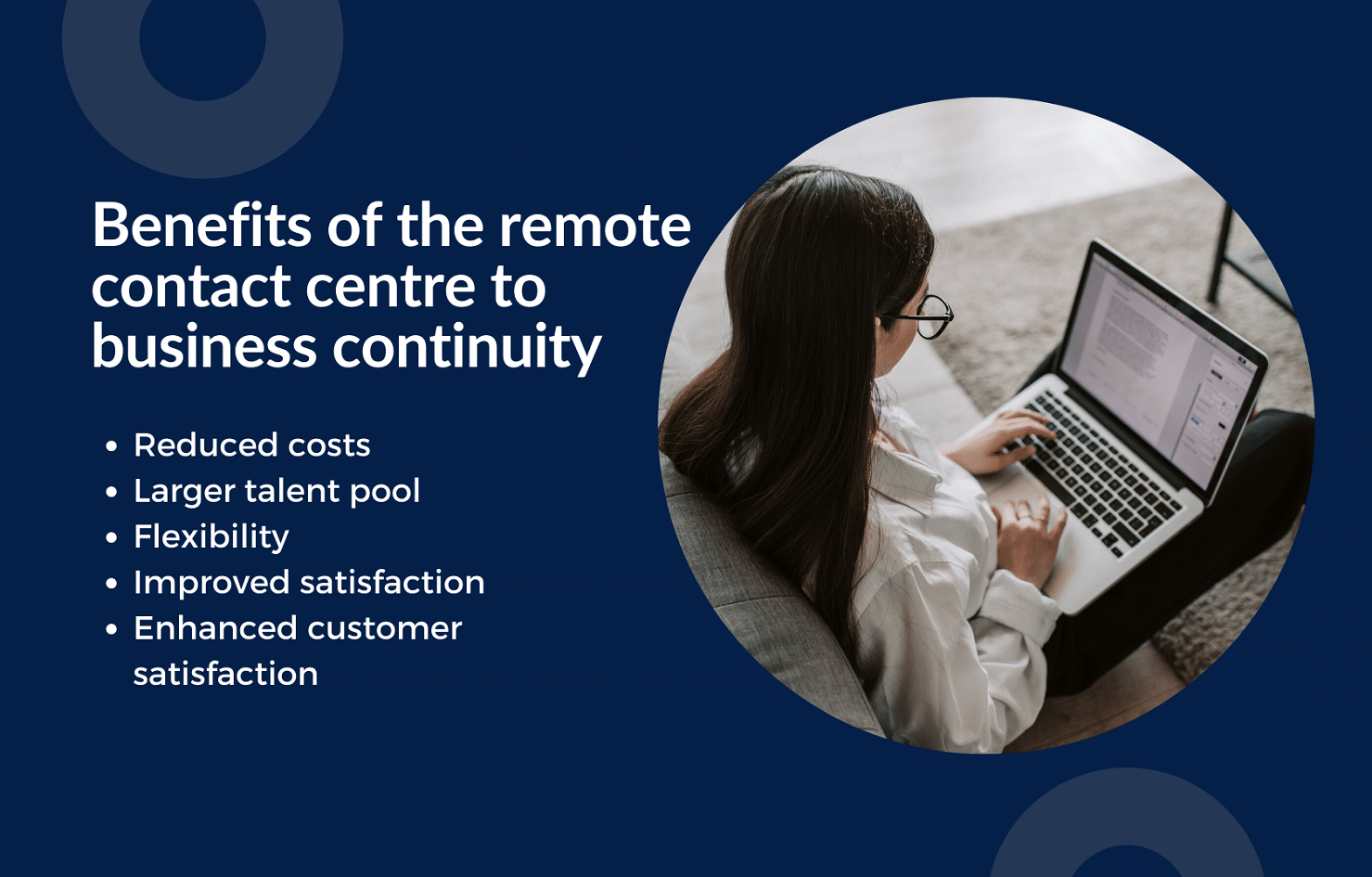Companies are thinking more seriously about business continuity today. We will see how businesses could design business continuity plan with remote contact centre.
The rise of the COVID-19 crisis meant that many of us saw first-hand just how unprepared we might be for life outside of the office. Although many organisations have been making a gradual shift into the cloud, this new landscape has proven that we need to move a lot faster.

When COVID-19 hit, it forced countless businesses to send their workers home to help reduce the spread of infection. Although many office-based businesses were able to continue their work with the help of VPN services and cloud-based UC tools, contact centres struggled to take the same approach.
After all, call centre jobs can often involve interacting with sensitive information or using advanced tools to track conversations. If a business doesn’t already have a remote environment in place, launching a dispersed contact centre isn’t as easy as it seems.
The good news is this current issue highlights a significant gap in the business continuity plans of our current contact centres. Businesses need to act now if they want to ensure they’re prepared for anything in this ever-changing world.
Business resilience is a driver of remote working
There are many factors encouraging businesses to implement remote working policies today.
Research consistently shows that remote workers (or telecommuters) report significantly less stress when working remotely, as well as higher productivity levels. Additionally, company leaders have the potential to cut the costs of managing their workforce significantly with remote workers too.
By giving employees more freedom in where they work, businesses are helping to reduce the work-related burdens that we face every day, such as exhausting commuting times. Studies indicate that working from home elevates team satisfaction levels while reducing attrition.
How businesses can be prepared during a pandemic
It’s only recently that we’ve discovered being prepared with a remote contact centre could be crucial to keeping a business running in times of crisis. When a global event, or even a localised disaster, prevents your call centre from operating as normal, a remote strategy ensures experts can continue their call centre jobs from home.
Far from facing problems with procrastination, organisations with remote working employees frequently find their team members work harder and accomplish more in a remote environment. Stanford found that remote workers are 13% more productive than their in-office counterparts, and they’re less likely to take sick days.
Unfortunately, the remote call centre only enables business continuity when companies are prepared to transition effectively into this new style of work. Leaders need to plan in advance, considering what their employees need to successfully and safely carry out their work from a remote location.
The recent COVID-19 crisis suggests that the majority of contact centres in the UK simply aren’t prepared. The Virgin Media brand even needed to ask customers to stop calling when its call centres were overwhelmed during the pandemic.
The benefits of the remote contact centre to business continuity

For years, companies have discussed the benefits of having a remote workforce, mentioning everything from improved efficiency to reduced commute time. Yet, it’s only recently that we’ve begun to see how significant the remote contact centre is to business continuity.
For years, companies have discussed the benefits of having a remote workforce, mentioning everything from improved efficiency to reduced commute time. Yet, it's only recently that we’ve begun to see how significant the remote… Click To Tweet
Often cited benefits include:
-
Reduced costs
The most obvious benefit of remote call centres is that you reduce your business operational costs massively. Your people work from the comfort of their own home, which means there are lower office overheads to consider. What’s more, cloud-based software for contact centres is often much cheaper than on-premise hardware. This is crucial for business continuity, as when disasters happen, budgets are often reduced.
-
Larger talent pool
Contact centre jobs can go to anyone with the best qualifications in a remote landscape. There’s no need to stick with who is available in the general area. This can be crucial during disasters too. When local employees aren’t available to fill your contact centre, business leaders can reach out to other talent from around the world. This is also a great way to fill some of the gaps when call volumes are high.
-
Flexibility
Contact centres need to be more flexible than ever in this new environment. With a remote landscape, you can take on additional members of staff when your call volumes increase and reduce your subscriptions when you need less support. Companies can even offer “follow the sun” availability with employees from different time zones.
-
Improved satisfaction
The last thing any contact centre needs in a time of crisis is employee turnover. With a remote environment that gives employees more freedom, you can keep your staff happy and committed to your company. Remote employees have higher levels of job satisfaction and are often more efficient in the way they manage their time.
-
Enhanced customer satisfaction
With a remote call centre strategy, you can keep your customers happy, no matter what’s going on. In the case of the COVID-19 pandemic, a remote call centre would allow businesses to continue taking calls, even when the government lockdowns prevented large groups of staff from coming together in a specific space.
How to Setup your Remote Contact Centre
In times of trouble, a remote contact centre can offer incredible value to businesses of all sizes. Whether you’re a small company that’s just trying to keep the lights on, or a large enterprise trying to keep a global workforce connected, your remote environment will keep things moving smoothly. However, you’ll need to ensure that you have a strategy for building business continuity around remote working first.
To set your business up for a remote call centre, remember that success starts with the right culture. You need to have a consistent level of trust between your business supervisors and your team members. Expectations need to be laid out to help staff understand what kind of goals they should be working towards. A remote working policy often comes in handy during transitional periods.
Tips to maintain productivity in your remote contact centre

1. Put the right infrastructure in place
Agents need the right equipment to help them achieve their goals outside of the office. This means investing in a contact centre solution that operates on the cloud, providing the flexibility and opportunities that your team members need.
A cloud-based contact centre will provide your employees with the same tools they have in the office, wherever they are. This includes call routing and management tools, as well as analytics, and solutions for business phone numbers. You can even implement extra features into your cloud contact centre to help you track the performance of your workers. Workforce management tools and time-tracking technology ensure that you can see where the gaps in your performance results originate.

2. Encourage accountability
Though research does indicate that remote workers are often more productive than their in-office counterparts, business leaders still need to encourage this productivity. Your team members should know from day one what’s expected from them, and how you’re going to be measuring their performance. Ensure clear instructions and playbooks are provided for your agents.
Contact centre management tools that allow you to track things like the number of calls an agent takes, or how quickly issues are resolved, could make a huge difference to your business reputation. Tracking tools in the remote call centre could also mean that you can implement gamification into the workplace. Allowing contact centre agents to compete for prizes can boost engagement and drive better outcomes.
3. Keep everyone connected
Remote call centre agents don’t need to be out of mind just because they’re out of sight. To improve engagement and productivity in this remote environment, ensure your people can collaborate. Instant messaging tools like RingCentral Glip for quick conversations, and video conferencing services can keep your employees connected, wherever they are.
Setting up regular sessions where your employees can interact and formulate bonds could make it easier for you to avoid attrition or turnover in your workforce. Remember, it’s also important to make sure your remote agents are aware of all the latest things that are happening in your business. Newsletters that update them on the issues that you’re facing and how you’re dealing with them can reduce nervousness among teams.
4. Offer training if necessary
A remote contact centre agent can still access training and growth opportunities if they’re not in the office. Online webinar tools and video conferencing offer great opportunities for easy training. These tools could be essential as you continue to learn more about what your customers need in times of crisis. To make sure you’re setting your agents up for success, offer training based on what you learn about their performance and skills.
For instance, monitoring service levels in your cloud contact centre will help you to see where your agents have issues with things like managing customer sentiment or reducing call handling times. You might even decide that you want to implement a multi-channel remote contact centre, which means training employees how to manage new environments.
5. Think about management and security
Finally, remember that ensuring business continuity with a remote contact centre isn’t just about giving your team members access to the right communication tools. You also need to ensure that your agents can access the same kind of experience that they get in the office, no matter where they are.
Work with a CCaaS provider that can give you a secure and reliable way to manage customer conversations. You may need a solution that works with a VPN gateway, or a service that integrates with services for tracking things like toll fraud. Some leading contact centre providers might even use things like artificial intelligence to highlight potential issues with the security of your conversations.
Think about how you can set up a contact centre on the cloud that not only maintains “business as usual” for your employees and customers but provides them with peace of mind too.
The rise of the remote call centre
The keys to success in this new remote working landscape are a combination of the right planning and the right vendor support. Having the right strategy in place to pivot to a new contact centre in the cloud will ensure your employees feel comfortable making the switch when you need to enact your disaster recovery plan.
On the other hand, the right CCaaS vendor will ensure you not only maintain the security and productivity of your traditional contact centre in the cloud but unlock new opportunities too. For instance, the future of remote contact centres could include:
- Access to virtual assistants that help to automate IVR processes and provide agents with more contextual information about their customers.
- Artificial intelligence that provides predictive analytics and sentiment analysis to enhance and improve the customer journey at every touchpoint.
- Increased connectivity through stronger technology, including 5G connections for employees that need to work from a mobile environment.
- New opportunities for multi-channel contact centre management, with features like SMS, instant messaging, and video built into the landscape.
Unlocking your business continuity strategy
As businesses continue to discover just how productive and efficient agents can be when they’re working from home, remote call centre jobs will increase. Thanks to CCaaS providers that can offer an excellent combination of reliable phone services, advanced tracking tools and security, companies of all sizes can begin to move their contact centre to the cloud.
What’s more, if you already have existing technology in the cloud, you can think about combining multiple components of your communication strategy. For instance, a CCaaS solution that works alongside a UCaaS service will ensure you have an excellent environment for both internal and external conversations. This cloud solution will continue to work effectively even when your employees can’t access the traditional contact centre or office.
Are you ready to future-proof your contact centre and take your business continuity strategy to the next level? Contact RingCentral to find out more.
Originally published May 07, 2020, updated Jan 17, 2023